The ESB National Grid is Ireland's Transmission System Operator and this paper about renewable energy is written from that perspective. First, I will introduce the role and responsibilites of a Transmission System Operator (TSO); I will then discuss the impact of changes in the way electricity is generated on the system's development; and finally look at some TSO initiatives. I will use the three-letter acronym TSO because it makes my presentation a little easier.
The TSO is responsible for the development, operation, and maintenance of the transmission system. Although the role of the TSO role is currently filled by ESB National Grid, it will be performed by EirGrid when the infrastructure agreement and transfer agreement between ESB and EirGrid are complete.
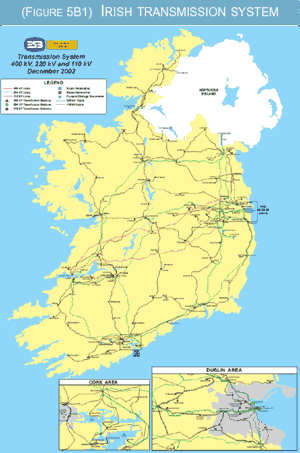 |
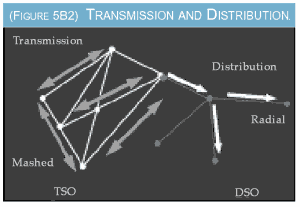 |
A transmission system is a mesh or a network which means in electrical terms it is normally closed and it is designed to withstand the loss of any single item of plant without the system going outside set standards. Flows can go in either direction along the lines and it is normally used for the delivery of bulk supply to the distribution network which is shown in Figure 5B2 as a radial or normally open system. Normally, electricity flows from the transmission system to the distribution system, and on to the local customers. However, if a generator is embedded in the distribution system, the flows can also go in either direction.
One of the advantages of the network aspect of the transmission system is the high level of security and continuity it gives. Both of these are very important, obviously, for our major industrial customers. Indeed one of their main issues when they meet us is the levels of quality and continuity that they can expect. The disadvantage is that a connection, be it an increased demand, or increased generation, at one node can cause changes throughout the network and at quite remote points, which makes the system more complicated to operate and control, whereas with a radial system the loads and demands and generation on any branch can be calculated by a simple arithmetic sum. Basically, though, in the Irish system, the Transmission System Operator looks after the transmission system and the Distribution System Operator looks after the distribution system.
Another comment on our system: it is a small island system. I read something recently by an academic in the UK who had described the UK system as an island electricity system, so certainly I think we could regard Ireland as a small island system. Our generated system peak is just over 4000 megawatts with a summer night valley or minimum load at just less than 1500 megawatts. We are lightly interconnected with Northern Ireland, which is lightly interconnected with the UK. As a result, a small amount of generation in European terms, say, 400 megawatts, has a big impact on our system.
The TSO's responsibility is to maintain, operate and, if necessary, develop a safe, secure, reliable, economic and efficient electricity transmission system and to explore and develop opportunities for interconnecting that system with other systems so that all reasonable demands for electricity are met while having due regard to the environment. That is the context in which we are operating.
So what impact will the development of many more electricity sources have on system development for the TSO in Ireland? What changes are we seeing? On the traditional thermal side, we are certainly seeing an increase in unit size, up to 600 megawatts now being typical and possibly even larger for nuclear stations. This has transmission system and reserve implications for the Transmission System Operator. On reserve requirements, our current standard is that we must have the ability to withstand the loss of our largest generator, so as the single largest unit increases, that has implications for us.
RENEWABLES IN THE SUPPLY MIX
There is now an increasing proportion of renewables in the overall generation mix. Small synchronous generators using predictable fuel sources create no new issues for a Transmission System Operator. If they act very much the same as any other generator, they really make no difference from the point of view of a system planner. But of all the renewable generation sources, wind, a very large natural resource in Ireland, does pose a great challenge for TSO, for two main reasons. One is the operating characteristics of wind turbine generation. Intermittence is one everyone is familiar with. The other is fault ride-through, the ability of the generator to stay connected when there is a fault on the system. I'll go into that in a little more detail. As I explained earlier, we have to be able to withstand the loss of our largest generator but, with current wind turbine technology, our dynamic models tell us that whenever we have, say, a cable fault close to, for example, our largest 400-megawatt generator on the system, Synergen, in Dublin, that would also trip every wind farm connected to the system for quite a large radius. This therefore means that not only do we have to be able to withstand the loss of Synergen but also every transmission- connected wind farm within a large radius as well. That is serious since the size of wind farms is increasing. We have recently signed a connection agreement for an 82.5 megawatt wind farm.
These are the challenges we are facing. On top of those, there are legislation issues and a lot of uncertainties about where our generation and our demand will come from, which is why we do scenario planning and construct models. It takes time to build in any reinforcements required to handle these various different uncertainties.
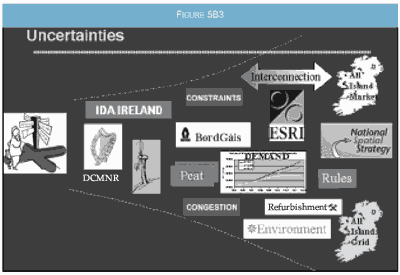 |
So, as I said, even a small amount of generation in some locations could result in a major transmission project. It just depends what the existing capacity is at that location and what impact it has on the overall network. Transmission projects to facilitate additional generation can only begin when a relevant generator or demand customer signs a connection agreement. We operate that policy to avoid having plant built which will subsequently be stranded. Typical lead times for significant transmission projects are currently from four to eight years. This is much longer than in the past while the typical lead-time for generation plant is about one to three years, much shorter than in the past. There is a mismatch here. From an economic point of view, someone is losing if there is too much generation in a particular location, be it the generator or the system or the public.
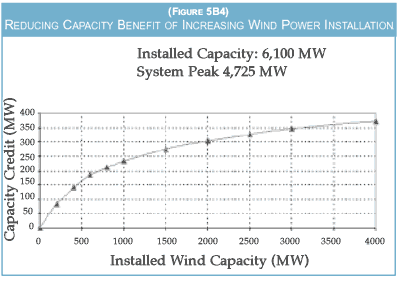 Another issue for us is the reducing capacity
benefit of increasing wind power installation.
As the level of wind power generation on the
system increases, the plant margin required to
maintain system adequacy rises as well. As an
example, we have currently 150 megawatts of
wind connected to the system. Most of this is
connected to the distribution side - only about
15 megawatts is connected to transmission.
Recently we had a high load period and we
required generation and we had only 3
megawatts available at that point in time as the
wind farms had too little wind to produce.
Another issue for us is the reducing capacity
benefit of increasing wind power installation.
As the level of wind power generation on the
system increases, the plant margin required to
maintain system adequacy rises as well. As an
example, we have currently 150 megawatts of
wind connected to the system. Most of this is
connected to the distribution side - only about
15 megawatts is connected to transmission.
Recently we had a high load period and we
required generation and we had only 3
megawatts available at that point in time as the
wind farms had too little wind to produce.
Figure 5B4 shows this issue. It is an input that ESB National Grid made to the Renewable Energy Strategy Group. It looks at a system peak of over 4000 megawatts which is not too dissimilar from where we are at the moment with only around 150 megawatts of wind installed. We do get some capacity benefits from that but as the windpower capacity increases, we get less and less benefit from each unit of wind capacity installed because we have to provide a back-up for it in case it is not available.
INTERCONNECTORS
An interconnector with another country's grid
can facilitate power flow in both directions.
Currently, as I said, we have interconnection
with Northern Ireland, which has interconnection
to the UK, into Scotland and down through
England and indeed England is interconnected
to Europe.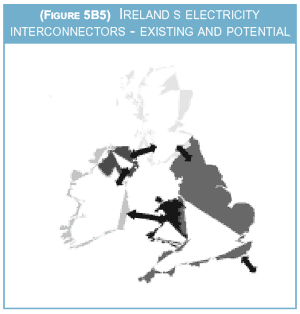 I have drawn a double-headed arrow
between Wexford and Wales to represent possible
interconnection between the Republic of
Ireland and the UK. This is a proposal which
has been discussed for some time and it is currently
being reviewed again. The EU would like
to see greater interconnection and it has been
specified as 10% of installed capacity.
I have drawn a double-headed arrow
between Wexford and Wales to represent possible
interconnection between the Republic of
Ireland and the UK. This is a proposal which
has been discussed for some time and it is currently
being reviewed again. The EU would like
to see greater interconnection and it has been
specified as 10% of installed capacity.
An interconnector would certainly be a significant intrastructural project. It would bring Ireland closer to the markets in the UK and it would facilitate more competition in the Irish market. Whether there would be cheaper imports from the UK is questionable, however, but it would give us energy-source diversity. Imports through it could be seen as equivalent to extra generation on the east coast; but, equally, since the arrow goes the other way as well, it could facilitate the export of power from there. The various pros and cons and different impacts are going to have to be taken into consideration when interconnection is being assessed.
We have put up a number of different information documents on our website at www.eirgrid.com. These mostly fall into the following categories: system, charges, connection and market, and one of the main pieces of information which will be useful to people in the generation area, is the forecast statement, which more or less shows the network currently, the reinforcements we intend to make, those for which we have capital approval to complete, and what capacity is available in the network for increased generation etc.
We are involved in the British Isles Wind Technical Panel, a group of TSOs and others who want to be able to model power supplies from wind farms just as they would model those from any other large generator. We are also a technical advisor to the Grid Investment Steering Group and have submitted discussion documents to the Commission for Electricity Regulation (CER) on the implications of large wind farms connecting to the grid and the specific requirements of the grid for that. We've been analysing various wind forecasting simulation systems such as Prediktor, which is used by one of the Danish utilities. We are involved in an EU group called More Care, again to do with wind forecasting, involving academics, TSOs and industry people. We are also part of another study on the impact of large amounts of wind generation on the performance of other generators if wind can't provide the generation at a given point in time and other generators have to. We have also made inputs into the joint British Office of the Regulator of Electricity Generation (OFREG) and CER wind study, which is being carried out at present.
Technical advances could help increase the amount of wind-generated energy that can be connected to the transmission system without diminishing the quality and continuity of supply. For example, a number of turbine manufacturers are working to improve the fault ride-through capability I mentioned earlier because the ESB is obviously not the only transmission system operator to raise this issue with them. The provision of frequency support and ancillary services, currently available from the thermal generators, is also important as the more that large wind farms can act like traditional power suppliers, the more people will be able to enjoy the same quality of supply from the transmission grid and yet have green energy.
ENERGY STORAGE
Accuracy of wind forecasting is obviously a major issue, and as I have said, we're doing a significant amount of work on that at the moment. Dispatchability, that is central control for larger wind farms, is highly desirable as it enables the TSO to actually instruct the wind farms to switch on or off their banks of turbines. And energy storage is obviously a key issue because a wind farm with energy storage provides the TSO with a lot of the advantages of the traditional thermal generator.
A final comment. As Transmission System
Operator, as I have outlined, our main duty is
maintaining the integrity of the main grid. We
are currently working with a lot of wind farm
developers and a huge effort has been put in by
them and their manufacturers and consultants to
try to accommodate our needs when they are
discussing generator connections with us. That
is part of the way forward just as here today we
are trying to understand each others' needs and
establish a collaborative process for the future.
This is one of almost 50
chapters and articles in the 336-page large format book, Before the Wells
Run Dry. Copies of the book are available for £9.95 from Green Books. Continue to Part C of section 4:Selling Green Electricity: A Wind Farmer's View
